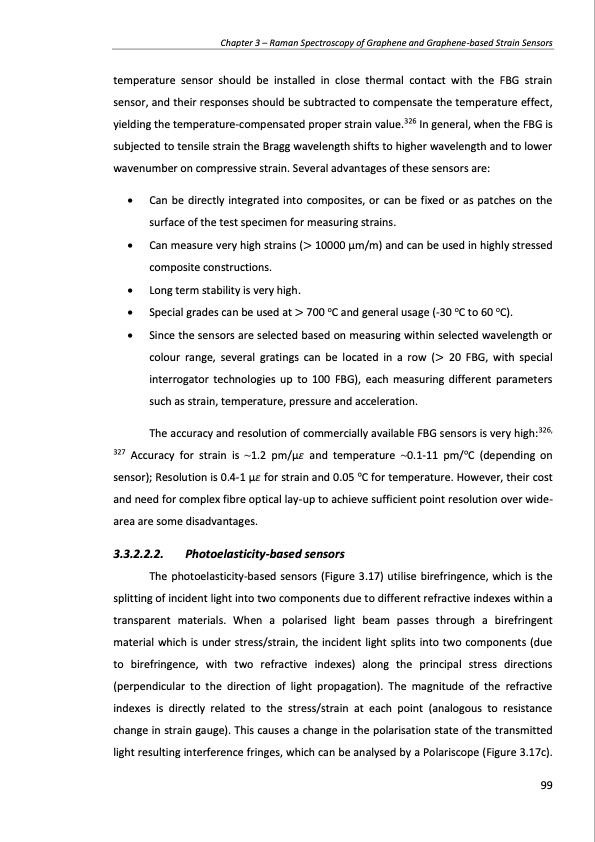PDF Publication Title:
Text from PDF Page: 099
Chapter 3 – Raman Spectroscopy of Graphene and Graphene-based Strain Sensors temperature sensor should be installed in close thermal contact with the FBG strain sensor, and their responses should be subtracted to compensate the temperature effect, yielding the temperature-compensated proper strain value.326 In general, when the FBG is subjected to tensile strain the Bragg wavelength shifts to higher wavelength and to lower wavenumber on compressive strain. Several advantages of these sensors are: Can be directly integrated into composites, or can be fixed or as patches on the surface of the test specimen for measuring strains. Can measure very high strains (> 10000 μm/m) and can be used in highly stressed composite constructions. Long term stability is very high. Special grades can be used at > 700 oC and general usage (-30 oC to 60 oC). Since the sensors are selected based on measuring within selected wavelength or colour range, several gratings can be located in a row (> 20 FBG, with special interrogator technologies up to 100 FBG), each measuring different parameters such as strain, temperature, pressure and acceleration. The accuracy and resolution of commercially available FBG sensors is very high:326, 327 Accuracy for strain is ~1.2 pm/μ𝜀 and temperature ~0.1-11 pm/oC (depending on sensor); Resolution is 0.4-1 μ𝜀 for strain and 0.05 oC for temperature. However, their cost and need for complex fibre optical lay-up to achieve sufficient point resolution over wide- area are some disadvantages. 3.3.2.2.2. Photoelasticity-based sensors The photoelasticity-based sensors (Figure 3.17) utilise birefringence, which is the splitting of incident light into two components due to different refractive indexes within a transparent materials. When a polarised light beam passes through a birefringent material which is under stress/strain, the incident light splits into two components (due to birefringence, with two refractive indexes) along the principal stress directions (perpendicular to the direction of light propagation). The magnitude of the refractive indexes is directly related to the stress/strain at each point (analogous to resistance change in strain gauge). This causes a change in the polarisation state of the transmitted light resulting interference fringes, which can be analysed by a Polariscope (Figure 3.17c). 99PDF Image | PRODUCTION AND APPLICATIONS OF GRAPHENE AND ITS COMPOSITES

PDF Search Title:
PRODUCTION AND APPLICATIONS OF GRAPHENE AND ITS COMPOSITESOriginal File Name Searched:
graphene-production-applications.PDFDIY PDF Search: Google It | Yahoo | Bing
Salgenx Redox Flow Battery Technology: Power up your energy storage game with Salgenx Salt Water Battery. With its advanced technology, the flow battery provides reliable, scalable, and sustainable energy storage for utility-scale projects. Upgrade to a Salgenx flow battery today and take control of your energy future.
CONTACT TEL: 608-238-6001 Email: greg@infinityturbine.com (Standard Web Page)